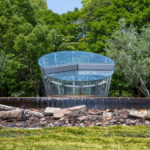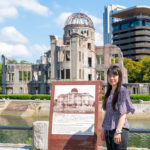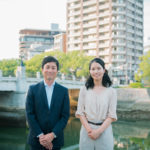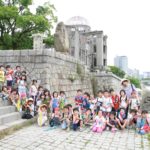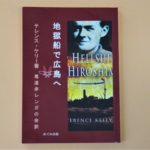IV Experiencing the Atomic Bombing and Survivors’ Personal Perspectives on Peace
1 What Did the A-bomb Survivors Experience? What Do They Want to Communicate? 1)
After the so-called “lost decade” of 1945-1954 2) and until today, the A-bomb survivors have continued to call for the total abolition of nuclear weapons and national indemnities.3) Though there are still some issues to be resolved, it is true that support measures for the victims have expanded through the ceaseless efforts of the A-bomb survivors themselves and their support organizations.4)
On the other hand, when it comes to the total abolition of nuclear weapons, nuclear powers still exist, including the United States, Russia, France, the United Kingdom and China. Collectively, the nuclear powers possess approximately 17,000 nuclear warheads.5) It is easy to imagine the anger, frustration, and resignation that many survivors feel, as well as their earnest hope for the abolition of nuclear weapons.6)
This section takes up the survey titled, “Questionnaire Survey: 60 Years after the Atomic Bombings” conducted by the Asahi Shimbun in April 2005 and examines the survivors’ responses to the open-ended questions to shed light on the character of their testimonies of their experiences and their messages to future generations. This is not only a summary of their experiences and messages but also a study to clarify the main elements of their experiences, messages, and sentiments. At the same time, it is also an exploration of their personal perspectives on peace. Of course, there are other methods to analyze and examine their perspectives on peace, such as the association test conducted by Masatsugu Matsuo in 1983.7) However, because their individual experiences of the atomic bombings from the foundation of their views on peace and their perspectives are most clearly expressed in their messages, this analysis of the A-bomb Survivor experiences and messages is considered an appropriate method to investigate. Therefore, the examination of the details of their experiences and messages leads to more complete understanding of their personal perspectives on peace. The survivor experiences and messages taken up in this study seek to clarify the core elements as well as to summarize them. This means that the points of views on peace explored here may also show the core elements and summaries of survivors’ peace perspectives. Please note that since this questionnaire study was conducted with the cooperation of A-bomb survivor organizations in various prefectures, the findings may be limited to this particular population and may not be representative of survivors as a whole. While these constraints exist, it is significant that data from approximately 7,000 A-bomb survivors was quantitatively analyzed to better understand their viewpoints on peace, which had been a mere assumption. This study confirmed that what had been previously discussed was correct. It is significant that the perspectives revealed here are considered to be applicable, to a large degree, when explaining the peace perspectives of A-bomb survivors as a whole.
2 Data and Methods
The Asahi Shimbun’s “Questionnaire Survey: 60 Years after the Atomic Bombings” targeted 38,061 people who possessed either the Atomic Bomb Survivor’s Certificates or the Class 1 Health Check Certificates. It was conducted from March to April 2005 as a joint project with Hiroshima University. The self-administered questionnaire was mailed to the target population through the organizations of Atomic and Hydrogen bomb sufferers in each prefecture affiliated with the Japan Confederation of A-and H-Bomb Sufferers Organizations. Out of those targeted, the total number of respondents was 13,453 (a response rate of 35.3%). And out of that number, 6,782 respondents (50.4% of the respondents) filled in the open-ended questions with details of their experiences and messages. This paper analyzes the experiences and messages written by these 6,782 respondents and attempts to examine the distinctive characteristics of the identified main elements by gender, location (Hiroshima or Nagasaki), and survivor category (according to how they were exposed to radiation).
The methodology utilized in this analysis was to extract words that frequently appeared in the survivor experiences and messages and then conduct a quantitative analysis using multidimensional scaling, hierarchical clustering, and text mining. The statistical analysis software “R” was used in the quantitative analysis, and MeCab was used for a morphological analysis.8)
| Please write freely in response to the following topics. You may choose to write about only one topic, or all topics. 1. Something you find unforgettable about your A-bomb experience 2. A message for the people who died in the atomic bombing and/or for new generations 3. Any other matter you would like to bring to others’ attention/ or make known to others |
3 Results and Discussions
(1) Background of the Respondents
The average age of the respondents was 75.3 (age at the time of the survey). There were 3,272 men (48.2%) and 3,368 women (49.7%). With regard to age groups, the majority of the respondents were in their 70s (55.1%), followed by respondents in their 80s (22.2%) and 60s (18.2%). As for the prefectures in which they lived at the time of the survey, 1,993 respondents―which was the biggest number―lived in Hiroshima (29.4%), followed by 944 in Tokyo (13.9%), 815 in Nagasaki (12.0%), and 421 in Fukuoka (6.2%). With regard to locations, 4,298 were survivors of the Hiroshima bombing (63.4%), 2,257 were survivors of the Nagasaki bombing (33.3%), and three were survivors of the bombings of both cities (0.04%). With regard to the survivor category, 3,572 were those who were exposed directly (52.7%), 1,939 were those who were exposed upon entering the city in the wake of the atomic bombing (28.6%), 467 were those who were exposed while engaged in relief activities (6.9%), 56 were those who were exposed in utero (0.8%), and 729 were those who had Class 1 Health Check Certificates (those who were in the designated areas outside the cities of Hiroshima or Nagasaki on the day of the atomic bombing) (10.7%). As for what they were at the time of the bombings, 2,694 were schoolchildren (39.7%), 1,094 were citizens (adults) (16.1%), and 1,254 were soldiers or civilian employees of the military (18.5%).
(2) Core Elements of the A-bomb Experiences and Messages
a Analyses Conducted on All Respondents
Table 9-1 shows the top 50 words appearing most frequently in the experiences and messages written by the 6,782 respondents. In general, the words extracted were limited to nouns, adverbs, adjectives, and verbs that describe the damages of the atomic bombings. Next, the relationship between words was calculated to show their degree of association, based on how often they were used simultaneously. Then, these 50 words were classified using hierarchical clustering (a method of data mining). The results are presented in Figure 9-1. To show closely-linked words in Figure 9-1, five groups are indicated with curly brackets, classification numbers and descriptions. Also, in Figure 9-2, multidimensional scaling was used to visually indicate the degree of association between words; and four spheres (dashed lines), sphere numbers, and content descriptions have been added to show the author’s interpretations. There is information loss associated with the use of the projection plane, and there are several assumptions and some limitations, but this study also closely examines the written content and employs simple spheres as much as possible. The classification numbers in Figure 9-1 and the sphere numbers in Figure 9-2 correspond mostly of the time, except for (4) and (5) in Figure 9-1, which correspond to (4) in Figure 9-2.
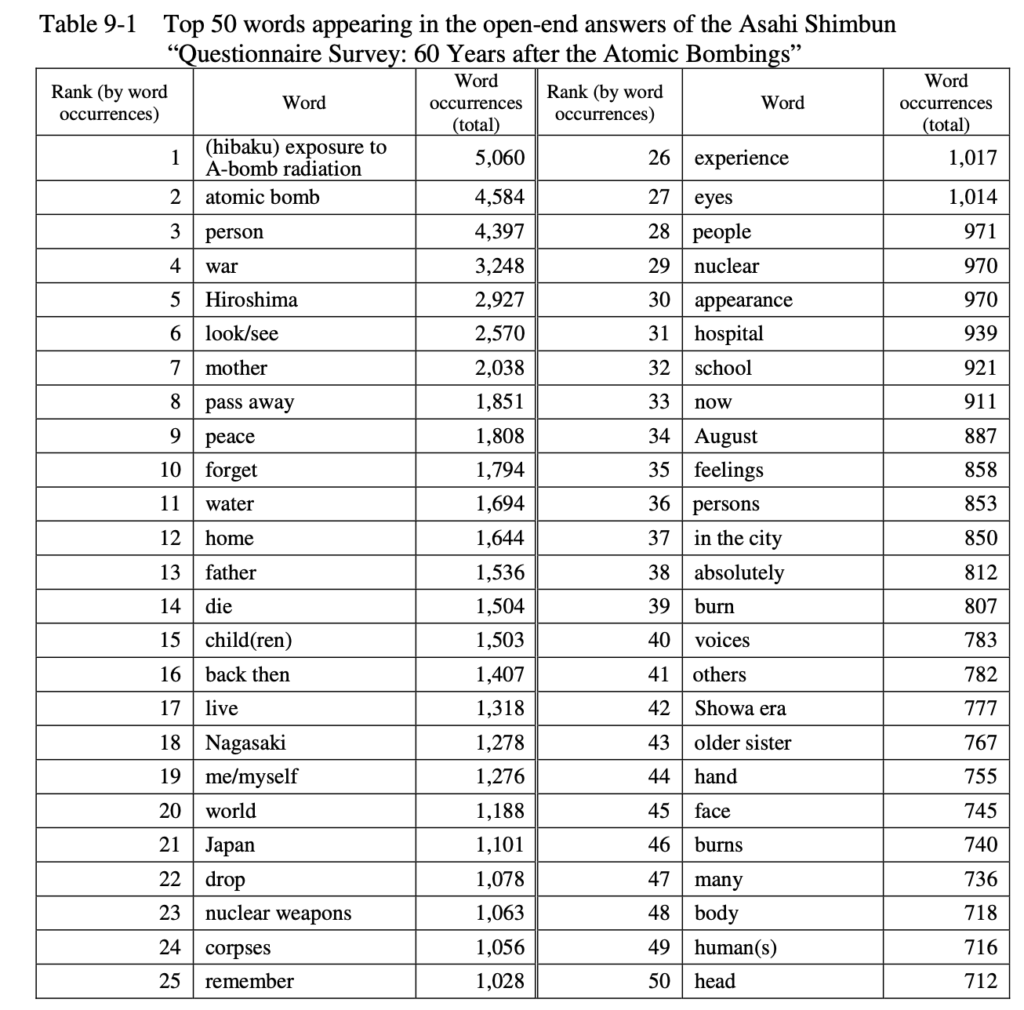
Hereafter, an attempt will be made to interpret the survivor messages and recounts of the atomic bombings and of their experience based on Figure 9-1 and Figure 9-2. In general, group (1) in Figure 9-1 and sphere (1) in Figure 9-2 show the key words used in the A-bomb survivor messages; and (3), (4), and (5) in Figure 9-1 and (3) and (4) in Figure 9-2 show the survivor recollections of their individual experiences during the A-bombings. In addition, (2) in both Figure 9-1 and Figure 9-2 include elements of both the messages and recollections of their experiences.


As shown in Figure 9-2, words related to their recollections of their experiences can be mainly classified into two groups. One group is the cluster of words in sphere (4) in Figure 9-2. The injuries inflicted on survivors right after the bombing were often described using such words as “head,” “face,” “hands,” and “burns.” At the same time, the conditions in the “hospitals” that accommodated the survivors and of the “corpses” left everywhere are talked about. The proximity of “water” and “voices” refers to the voices of the survivors on the brink of death, asking for water. Thus, it can be understood that sphere (4) is a cluster describing the unforgettable hellish scenes from after the bombing. Excerpts from accounts with illustrative examples of the use of the words “water” and “corpses” are shown below.
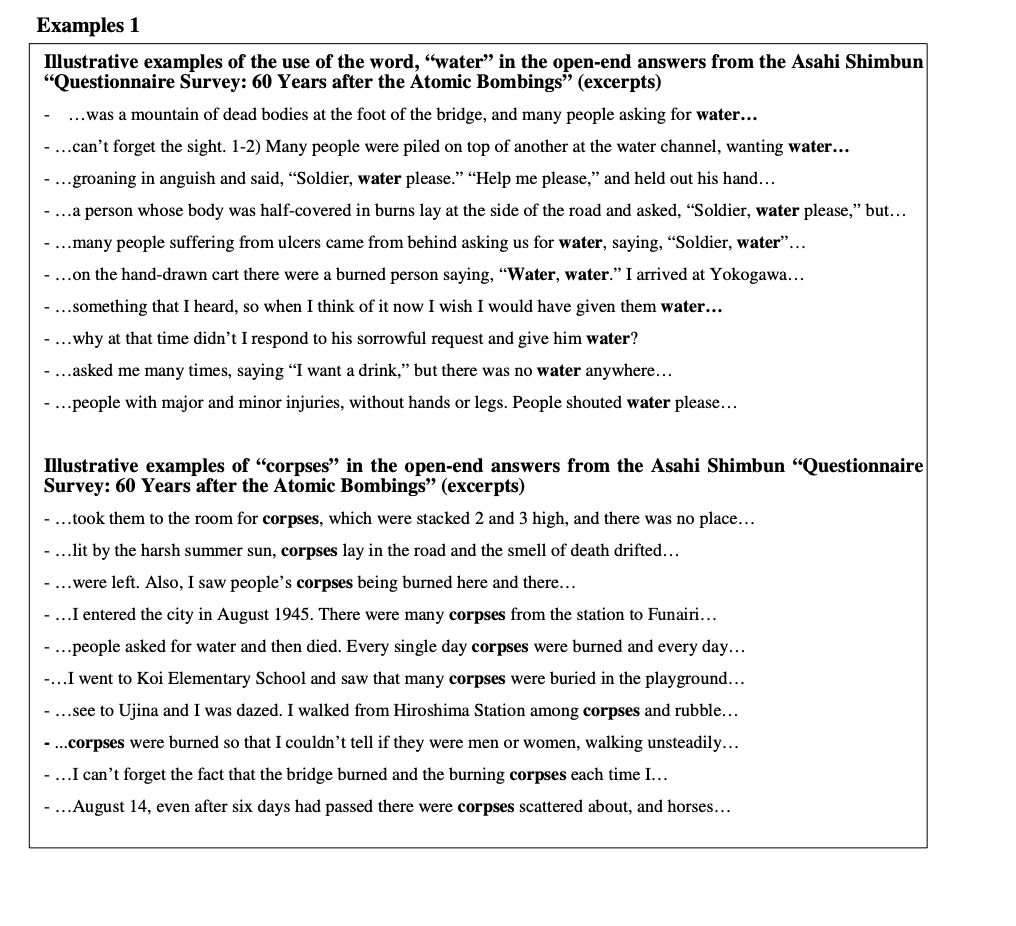
The other grouping is the cluster of words in sphere (3). This can be interpreted as a group recounting their experiences following the A-bombing in relation to family, such as “mother,” “father,” and “home.” It reveals that the deaths of their parents in the bombing or the experiences involving their parents constitute important factors in the recounts of their experiences. Below are illustrative examples related to “father” and “mother.” Therefore, recollections of their experiences are primarily composed of two groups of experiences: those involving family and those of the unforgettable hellish scenes from after the bombing.
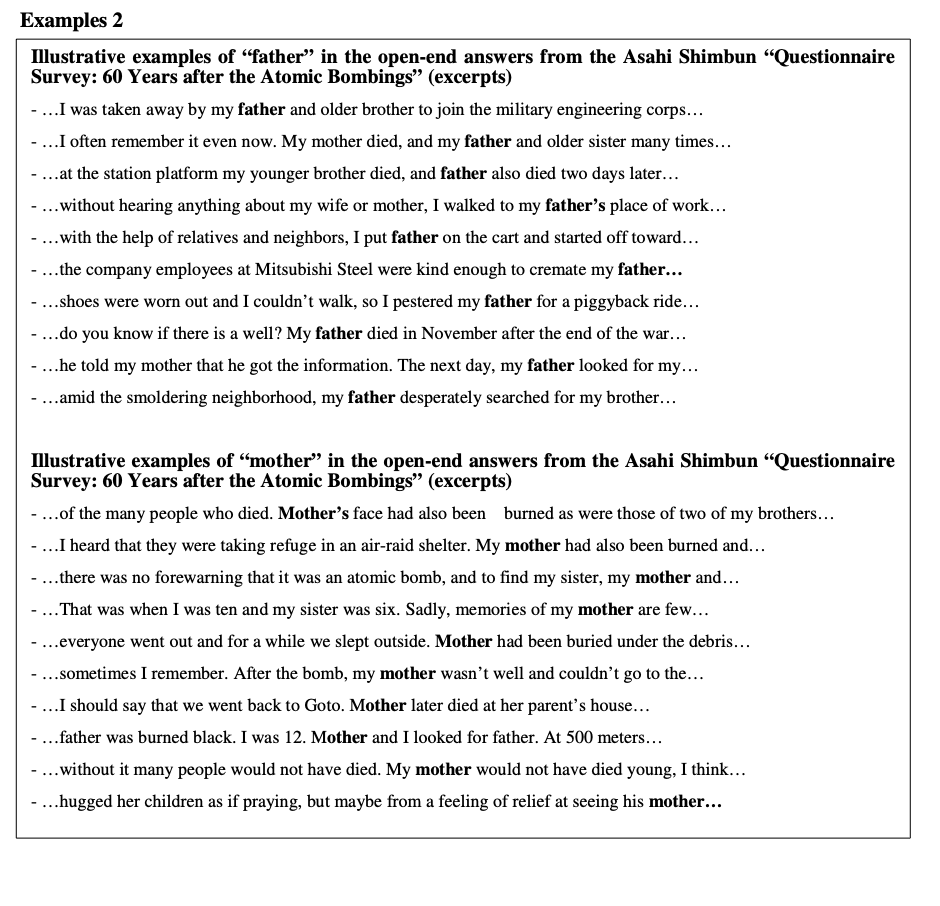
There is no need to conduct more detailed analyses of the testimonies of A-bomb survivors. As shown in Table 9-1, the words “world,” “peace,” “nuclear weapons,” and “nuclear” appear frequently, and it is clear that “world peace” achieved through “the abolition of nuclear (weapons)” is a key element. After having experienced the atomic bombing, the survivors advocate for a world peace without nuclear weapons. Messages from A-bomb survivors who lead the call for the abolition of nuclear weapons have been condensed here. In other words, this could be referred to as the essence of the survivors’ “viewpoints of peace.” The following are illustrative examples of the words “nuclear weapons/nuclear” and “world peace.” The straight dotted line in Figure 9-2 indicates the boundary between their messages and accounts of their experiences. The area above the dotted line can be interpreted as word groups primarily concerning recollections of the survivor experiences, while word groups below the dotted line show the key words of their messages.
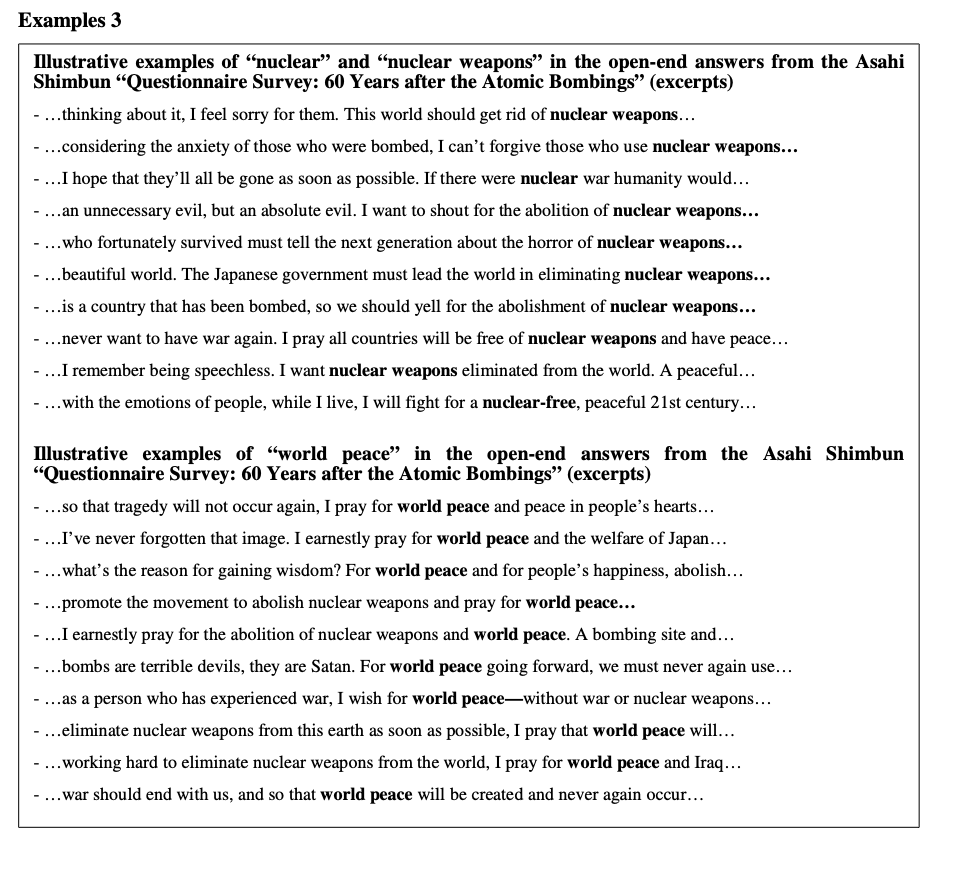
b Comparative Analysis by Gender
Table 9-2 is a comparison of the top 30 words by gender. The words used by both men and women are shown in bold in shaded cells. About 70% of these words are used by both men and women.

Overwhelmingly, women use the word “mother” quite frequently, and the words “father” and “older sister” only appear in the women’s writings. Thus, women tend to talk more about family when they talk about their experiences. Figure 9-3 shows the results of a multidimensional scaling of the 30 words. From that, it is apparent that men do not talk much about their families when they talk about their experiences. This doesn’t mean that men do not talk about their families at all, as “mother” is included in the list. However, women have a stronger tendency to talk about their families in relation to their experiences. Therefore, when it comes to recollections of their experiences, it is safe to say that emphasis in survivor accounts differ depending on the survivor’s gender. This analysis of the testimonies shows that men have a stronger tendency to advocate for peace through the abolition of nuclear weapons, while women have a stronger tendency to call for peace, by calling for not only the abolition of nuclear weapons but also the absolute renunciation of war. This suggests that “viewpoints on peace” also differ by gender.
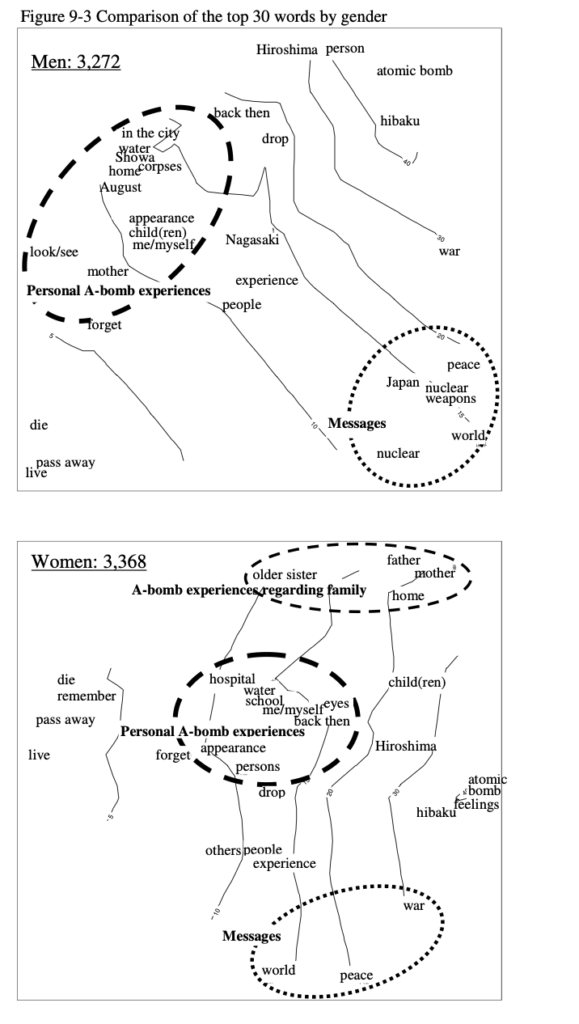
c Comparative Analysis of Hiroshima and Nagasaki A-bomb Survivors
Table 9-3 shows the top 30 words by location. The words used by the survivors of Hiroshima and Nagasaki overlap at a high rate of 87% (the shaded cells). Figure 9-4 shows the results of a multidimensional scaling of the 30 words. There is not much difference between the survivors of Hiroshima and those of Nagasaki. Although people often say there is “Anger in Hiroshima and prayer in Nagasaki,” this claim is not supported by this analysis. One possible explanation is that 60 years after the atomic bombing, the heart of the survivors’ feelings have become nearly identical.

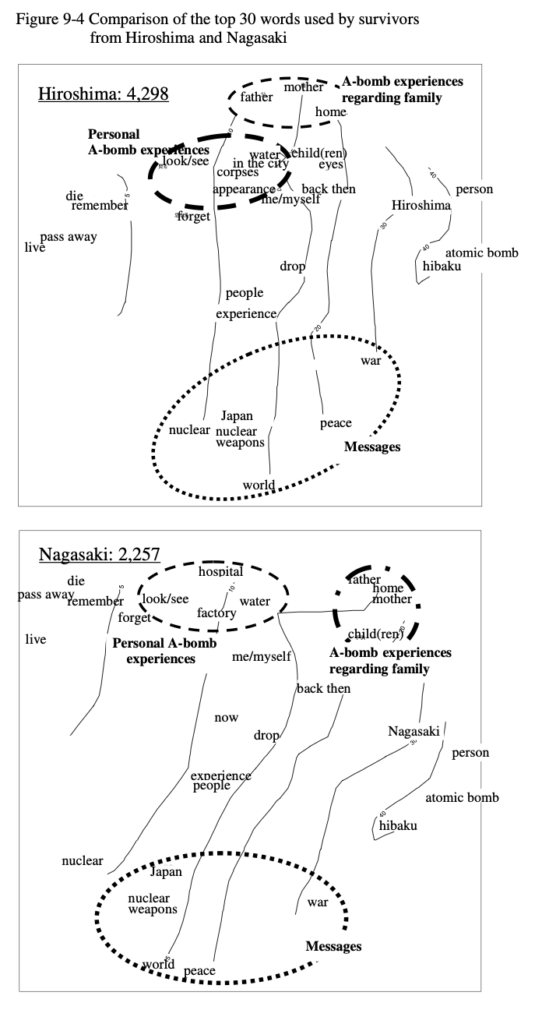
d Comparative Analysis of Survivors Aged Seven and Older at the Time of the Bombing and Survivors under Age Seven
Table 9-4 shows the top 30 words for the survivors aged seven or older at the time of the bombing (aged 67 or older at the time of the questionnaire survey) and for those younger than age seven. The words they used overlapped 70% of the time (shaded cells). Figure 9-5 shows the results of a multidimensional scaling of the 30 words. As shown in Table 9-4, in the case of survivors who were younger than seven years old, words that express indelible scenes after the bombing, such as “water” and “corpses” were not used. As shown in Figure 9-5, the survivors’ own experiences are not expressed. Instead, they used words such as “older sister,” “older brother,” and “family” in their descriptions. Which means their recollections of the bombings are experiences connected with their family members. Although they do not talk much about their own experiences, their messages calling for “world peace without nuclear (weapons)” are the same as those of the survivors aged seven and older.

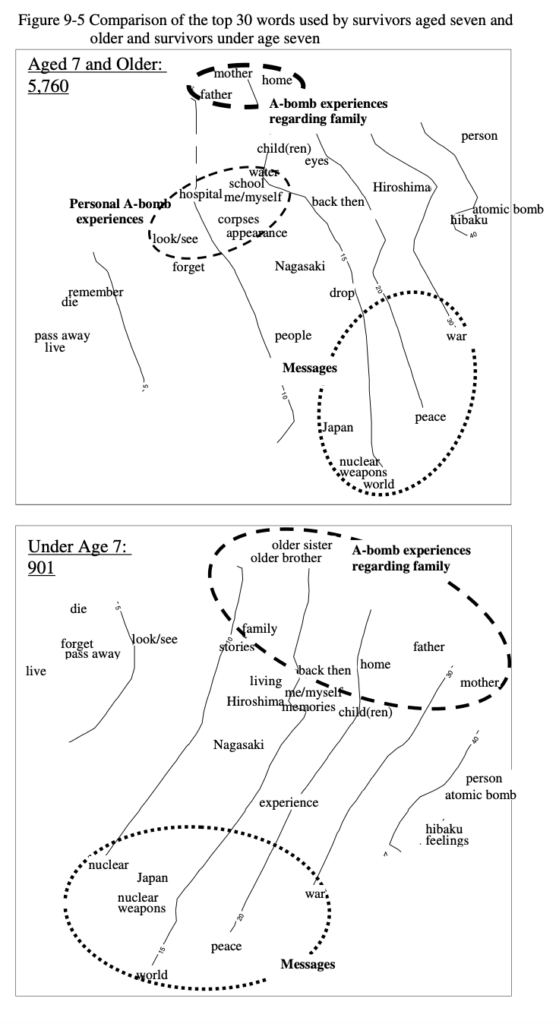
e Characteristics by the Survivor Grouping
Table 9-5 is a cross-tabulation table for the top 50 words appearing frequently in the accounts and messages of survivor separated by their groupings. (Groups were divided according to how they were exposed to the radiation of the A-bombings.) The frequently appearing words “Hiroshima” and “Nagasaki” were excluded, since they would are redundant when examining experiences and messages by location. A Correspondence analysis was conducted based on Table 9-5 and the visualization of this analysis is visible in Figure 9-6―to which five spheres (dashed lines) and sphere numbers have been added to show the author’s interpretations. While it is important to note that there is information loss associated with the projection plane, this study also examines the testimonies in detail, in order to draw simple but meaningful spheres as much as possible.

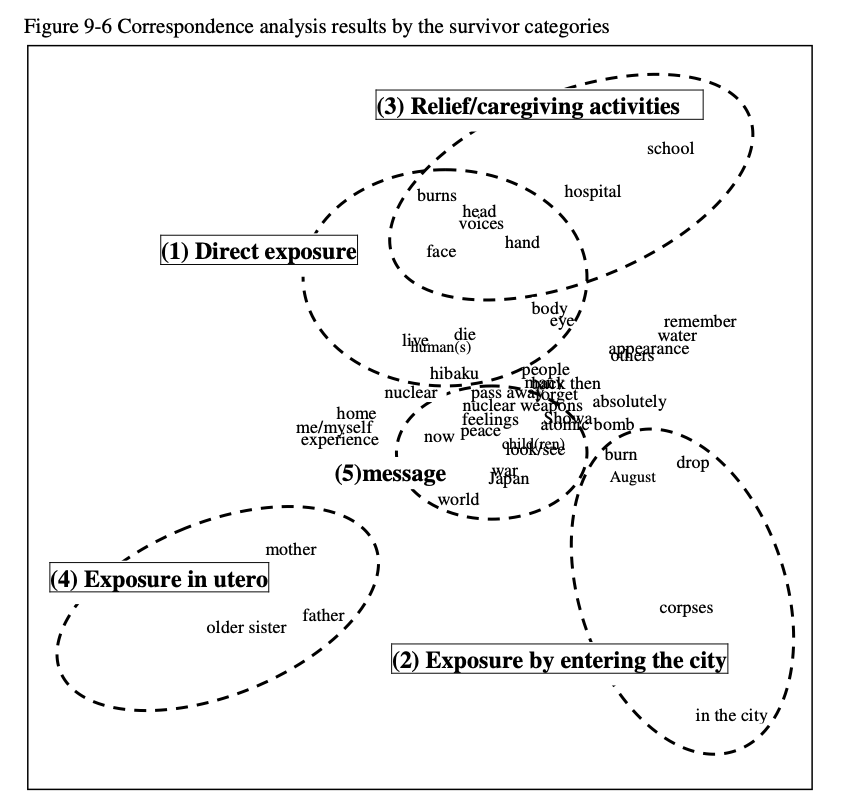
Sphere (1) represents words that are predominantly used when survivors directly exposed to the radiation of the A-bomb talk about their experiences. When speaking of their experiences, they tend to speak of hellish scenes after the atomic bombing, using such words as “burns,” “head,” and “face.” Sphere (2) represents words primarily used by survivors who entered the city in the wake of the bombing. They tend to talk about the scenes they witnessed “in the city,” using such words as “corpses” and “burn.” Comparing the two groups, it can be noted that survivors who were directly-exposed tend to talk about other survivors and themselves, i.e. what they saw during their escape from the disaster-stricken areas to the city outskirts. On the other hand, the survivors who entered the city tend to speak of the corpses left in the disaster-stricken areas. This difference may be due to the time gap between directly-exposed survivors fleeing from the disaster-stricken area to the city outskirts and the survivors arrived at the city to search for family.
Sphere (3) represents a group of words primarily used by those engaged in relief or caregiving activities. These individuals tend to talk about their experiences at places offering relief aid and caregiving, such as “schools” and “hospitals.” At the same time, they use words such as “burns,” “head,” and “hands” to talk about the injuries of the directly-exposed victims. In other words, with regard to the injuries suffered by the directly-exposed people, they witnessed the same scenes as what the directly-exposed survivors saw. Sphere (4) can be interpreted as a group of words predominantly used by survivors exposed in utero. They have a tendency to frequently use the words “father,” “mother,” and “older sister.” This is likely because they heard about the bombings from family members. As previously mentioned, this trend is also evident among survivors who were under age seven at the time of the bombing.
Sphere (5) represents shared elements of the survivor testimonies and feelings. Figure 9-7 is an enlargement of sphere (5). It indicates survivors’ feelings that advocate a “world” without “nuclear weapons” or “war”; or “peace” in “Japan.” The key elements of these messages suggest a feeling shared among the survivors, regardless of exposure categories. This indicates that the opinions on peace are shared by all A-bomb survivors.
In addition to the survivor groupings, the data was also examined by location and gender. Figure 9-8 shows the results of that examination. Within the same grouping of survivors, no prominent differences were observed in data by location or gender. As shown by the four spheres (dashed lines) added by the author, the data has primarily been organized in groups by survivor groupings. This shows that the survivor category has a greater impact on characterizing the contents of the survivors’ experiences, compared with the factor of locations or that of gender.
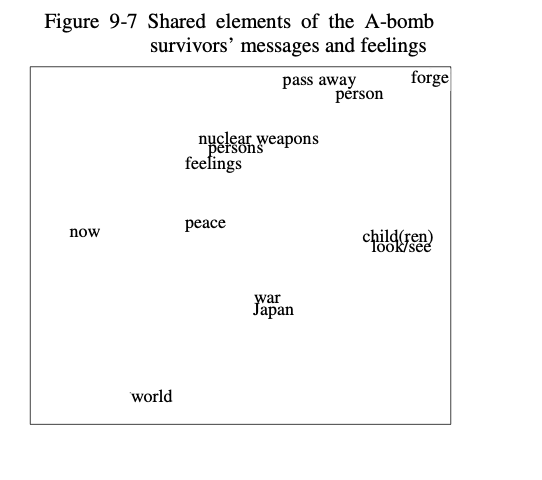

4 Summary
This section examines the essence of A-bomb survivors’ experiences (recognition structure of experiences), key elements of A-bomb survivor messages, and their characteristics by gender, location, age, and survivor category. Accounts of their experiences can be divided into two main groups: the indelible hellish scenes from after the bombing; and the experiences related to the survivors’ families. As for experiences analyzed by gender, women tended to talk more about their families in relation to their experiences, while men often advocated for “peace through the abolition of nuclear weapons.” A comparison between the testimonies of survivors of both Hiroshima and Nagasaki did not show any evidence of “anger in Hiroshima and prayer in Nagasaki.” Survivors under age seven at the time of the bombing largely spoke of their families in relation to their experiences, rather than what they saw right after the bombing.
In addition, when the A-bomb survivors speak of their experiences, the analyses suggests that what they tend to emphasize differs depending on the survivor category they belong to. The summary of the findings of this analysis of the distinct characteristics of survivors when researching them by their category are as follows:
- Directly-exposed survivors have a tendency to speak about their own injuries or other people’s injuries, using such words as “burns,” “head,” and “hands.”
- Survivors who entered the city in the wake of the atomic bombing have a tendency to speak about scenes they witnessed “in the city,” using such words as “corpses” and “burn.”
- Survivors involved in relief efforts and caregiving activities have a tendency to speak about experiences at locations where relief and caregiving activities were conducted, such as “schools” and “hospitals,” as well as a tendency to talk about injuries of directly-exposed victims, using such words as “burns,” “head,” and “hands.”
- Survivors exposed in utero have a tendency to speak of the experiences through their “father,” “mother,” and “older sister.”
Thus, this study has identified the differences in what the survivors remember about the atomic bombings depending on their survivor category. This indicates something important about their viewpoints. For instance, those who entered the city afterwards possess different viewpoints from directly-exposed survivors. As they entered the city sometime after the bombing, they tended to see the scenes around the hypocenter in more detail. This also suggests that taking into account their viewpoints is also essential to further understand the damage caused by the atomic bombings.
With regard to the survivor messages, which show their viewpoints on peace, the primary elements were “world peace,” through the “total abolition of nuclear (weapons).” Though there were slight differences in messages when separated by gender, there were no significant differences when by location, age, or survivor category are taken into account. “World peace” through the “abolition of nuclear weapons” has always been the core elements of survivors’ views on peace. It has been noted that “the total abolition of nuclear weapons” is one of the two main pillars of the peace movements promoted by A-bomb survivors, and the Nihon Hidankyo (Japan Confederation of A-and H-Bomb Sufferers Organizations) has also acknowledged this.9) A-bomb survivors typically have opinions that peace should be achieved “through the total abolition of nuclear weapons,” which is in a sense self-evident. This has been assumed from the words and actions of the peace movements spearheaded by A-bomb survivors but not proven by using statistical methods such as quantitative analyses before this statistical study, which provides evidence for what has been said about the A-bomb survivor perspectives of peace. This study also clarified that there is no difference in the main elements of the A-bomb survivor viewpoints on peace by location, age, or survivor category and that they share the same perspectives of peace. Until today, people have tended to describe feelings in Hiroshima and Nagasaki by there was “anger in Hiroshima and prayer in Nagasaki,” but this study has also found that Hiroshima and Nagasaki share highly similar opinions of peace. Even when taking into account differences in age, survivor category, and subsequent experiences, there are no significant differences in the opinions on peace held by the A-bomb survivors.
As a result of this study, it is clear that “world peace without nuclear weapons” is the key element of the A-bomb survivor views on peace, regardless of their category. At the same time, this study also suggests that gender differences may account for a different focus in the survivors’ in relation to achieving peace by gender. Men were more likely to desire world pace through the total abolition of nuclear weapons, while women were likely to desire world peace through absolute renunciation of war. Whether or not these trends can be made into a more general theme is something to be explored in the future.
The unique characteristics of A-bomb injuries―different from those of conventional weapons―are the radiation aftereffects, such as malignant tumors caused by radiation, or A-bomb diseases. In addition, A-bomb survivors are more concerned about their health because of their higher risk of developing illnesses. 10) What kind of vicious Pandora’s Box has humankind opened? According to the Ministry of Health, Labor and Welfare, there are 201,779 A-bomb survivors living as of the end of March 2013. There were 210,830 survivors living in March 2012. Approximately 9,000 survivors died over one year. The average age of survivors is over 78 years old. Eventually, there will be no survivors to recount their experiences of the atomic bombings, and the atomic bombings will only be told as a part of history. Sixty eight years have passed since the atomic bombings. Research on A-bomb injuries has steadily yielded results, indicating the atrocity of the atomic bombings. At the same time, the survivors of the atomic bombings share a strong determination to protest the possession of nuclear weapons based on their own tragic experiences, and have guided Japan―the only country that has experienced the atomic bombings―to do the same. By doing so they are overcoming their experiences of surviving the atomic bombings.
The “Questionnaire Survey: 60 Years after the Atomic Bombings” also asked the survivors what has supported them emotionally. Among the total number of 12,323 respondents, 7,703 (62.5%) responding with: “living with family”; 4,380 (35.5%) “hobbies”; 2,799 (22.7%) their “communities and social activities”; 2,257 (18.3%) said it was “the movement for the total abolition of nuclear weapons,” and 2,057 (16.7%) said “religious faith.”11) The survivors’ physical and psychological trauma was alleviated by their families, communities and the peace movements. With these supports, they have tried to overcome their tragic experiences and have established their perspectives of peace. How should future generations in Japan respond to the survivors’ thoughts and desires? This is a question that we must answer ourselves.
(Noriyuki Kawano)
Notes
1. This section is based on the author’s following three papers, which have been corrected, added and restructured by the author. Kawano, Noriyuki. “Genbaku Hibaku Higai no Gaiyo” (Outlines of Atomic Bomb Afflictions). Heiwa Kenkyu, No. 35: 2010, pp. 19-38. Kawano, Noriyuki; Sato, Kenichi; and Ohtaki, Megu. “Genbaku Hibakusha wa Nani o Tsutaetai no ka: Genbaku Hibakusha no Takenki/Messeji no Keiryo Kaiseki o Toshite” (What Do A-bomb Survivors Want to Communicate? A quantitative analysis of memoirs and messages from A-bomb survivors). Nagasaki Igakukai Zasshi, Special Edition Vol. 85: 2010, pp. 208-213. Kawano, Noriyuki. and Sato, Kenichi. “Genbaku Hibakusha no Taikenki/Messeji ni kan suru Hibaku Kubun-betsu Tokucho ni Tsuite” (Characteristics of memoirs and messages from A-bomb survivors by suvivor category). Hiroshima Igaku, Vol. 65 No. 4: 2012, pp. 322-326.
2. Japan Confederation of A- and H-Bomb Sufferers Organizations (Nihon Hidankyo) has named this period the lost decade of “living in seclusion and of enduring discrimination, the pain of illness, and poverty.” The Hiroshima Prefecture Confederation of A-Bomb Sufferers Organizations (Hiroshimaken Hidankyo) published “Kuhaku no Ju Nen” Hibakusha no Kuto (“The Lost Decade”: Struggles of A-bomb Suvivor) in August 2009. The book is composed of tabulations/analyses of the results of a questionnaire filled out by 7,438 survivors; and of 71 earnest memoirs detailing discrimination in the workplace and marriage, and their struggles with the aftereffects of radiation. The book explores the realities of that lost decade. For details, visit: http://www.ne.jp/asahi/hidankyo/nihon/about/about5-200910.html#anchor-04 (accessed as of January 31, 2014)
3. “A 50-year History” found in the website of the Nihon Hiankyo. For more details, visit: http://www.ne.jp/asahi/hidankyo/nihon/about/about2-02.html (accessed as of January 31, 2014)
4. However, this of course does not mean that compensation, etc. based on the Atomic Bomb Survivors Support Law is sufficient or that the survivors are satisfied with that compensation. In truth, according to the Asahi Shimbun “Questionnaire Survey: 60 Years after the Atomic Bombings,” approximately 47% of respondents indicate they are not satisfied with theri compensation. Details can be found in the Asahi Shimbun, July 17, 2005.
5. SIPRI. SIPRI Yearbook 2013. SIPRI, 2013.
6. More information on the feelings of the A-bomb survivors is available in, for example, the Asahi Shimbun “Questionnaire Suevey: 60 Years after the Atomic Bombings” and the Yomiuri Shimbun “1,000-person Questionnaire Survey: 65 Years after the Atomic Bombings” (July 30, 2010).
7. Matsuo, Masatsugu. Renso Chosa ni yoru “Heiwa” no Imi Bunseki (A Semantic Analysis on “Peace” According to an Association Experiment Survey). Institute for Peace Science, Hiroshima University, 1983.
8. For details, see Motohiro Ishida’s Tekisuto Mainingu Nyumon (Text Mining Guide) (Morikita Publishing, 2008) and Meitetsu Kin’s Tekisuto Deta no Tokei Kagaku Nyumon (Introduction to Text Data Statistical Science) (Iwanami Shoten, 2009).
9. The other pillar is the call for national indemnities for A-bomb survivors. For details, see the Nihon Hidankyo website: http://www.ne.jp/asahi/hidankyo/nihon/about/about2-02.html (accessed as of January 31, 2014)
10. According to the Asahi Shimbun “Questionnaire Survey: 60 Years after the Atomic Bombings,” over 90% of respondents felt anxiety over their health. Also, the degree of that anxiety depended on the distance from the hypocenters and on their suvivor category. For details, see: Kawano, Noriyuki; Otani, Keiko; Sato, Kenichi; Tonda, Tetsuji; and Ohtaki, Megu. “Genbaku Hibakusha no Fuando ni okeru Hibakujokyo Izonsei ni tsuite: Asahi Shimbunsha Anketo Chosa ni Motozuku Kaiseki” (Radiation Exposure Situation Dependency in Anxiety Levels of A-bomb Survivors: Analysis based on a questionnaire by the Asahi Shimbun). Hiroshima Igaku, Vol. 63 No. 4: 2010, pp. 270-274.
11.For details, see the Asahi Shimbun dated July 17, 2005 or Kawano ,Noriyuki ;Hirabayashi,Kyoko;andOtaki,Megu.“GenbakuHibakusha no ‘Kokoro’ to ‘Kurashi’ ni Okeru (Keizokuteki) Higai no Jittai: Asahi Shimbun ‘Hibaku Rokuju Nen Anketo Chosa’ Kekka o Tegakarini” (The Truth About Ongoing Harm to the Minds and Lives of A-bomb Survivors: A look at the results of the Asahi Shimbun “Questionnaire Survey: 60 Years after the Atomic Bombings”). Nagasaki Igakukai Zasshi, Special Edition Vol. 81: 2006, pp. 195-200.
Tags associated with this article



